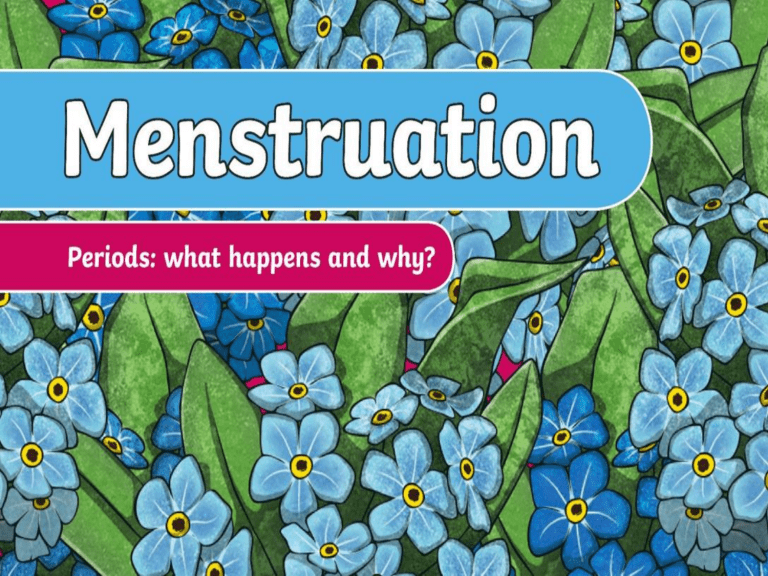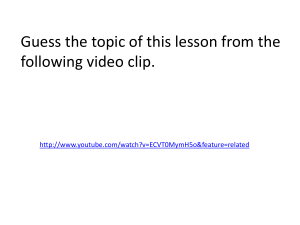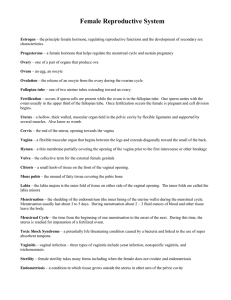
Menstruation Puberty and the Female Body You get taller and heavier. Your bones grow bigger and heavier. Hair grows under your armpits and around your genitals (pubic hair). Your face changes shape. Your voice gets a little deeper. Your hips get wider and more curvy. You start your periods. Partner Talk – What examples can you think of? Menstruation Puberty: What Happens to Girls? Your body sweats more. Your breasts and nipples get larger. Your internal and external sex organs grow. You may have mood swings and sexual thoughts and feelings. Your hair on your arms and legs grows darker. Menstruation The Female Reproductive System Fallopian Tube Egg Ovary Uterus Click the points for more information. Vagina Fallopian tube Ovary Egg Vagina Uterus AAcell The pair egg which oftravels female is the down the The A major opening organ of where the female the reproductive beginning tube toward of the organs a human uterus in reproductive human foetussystem. develops. which for embryo. ready eggs fertilisation. are produced. Menstruation What Are Periods? Periods (menstruation) happen due to the hormones changing in the body. Even before birth, a female baby has 1-2 million tiny eggs (ovum) in her ovaries. When puberty is reached, an egg is released each month from the ovaries. The egg moves from the ovary and along the fallopian tube and down into the uterus (womb). If the egg is not fertilised by a sperm, the lining of the uterus and the egg leave the body through the vagina; this is called a ‘period’. Menstruation Why Do Periods Start? Periods are caused by hormone levels changing within your body. They are nothing to feel embarrassed about. It is nature’s way of preparing the body for having a baby when you are older. Periods are a normal part of the female reproductive cycle. Partner Talk – What questions do you have about periods? Menstruation The Menstrual Cycle The menstrual cycle is usually around 28 days. However, it can vary from between 23-35 days. Menstruation The Menstrual Cycle Days 1-5 Fallopian tube Ovary Uterus Vagina The lining is lost from the uterus. This is called a period. Menstruation The Menstrual Cycle Days 6-13 Fallopian tube Ovary Uterus Vagina The lining of the uterus thickens to be ready to receive an egg. The egg will start to ripen on day 12. Menstruation The Menstrual Cycle Day 14 Fallopian tube Ovary Uterus Vagina This is called ovulation. When ripe, the egg is released from an ovary. Menstruation The Menstrual Cycle Days 15-28 The lining of the uterus will stop developing if the egg is not fertilised. The cycle will start again. Menstruation Stages of the Menstrual Cycle The graph shows how the thickness of the uterus lining changes during the menstrual cycle. Uterus lining builds up. Uterus lining remains thick. If the egg cell is not fertilized, the uterus lining breaks down again. Thickness of Uterus Lining Uterus lining breaks down (menstruation) . Day 1 Day 7 Day 14 Day 21 Day 28 Menstruation When Will My First Period Start? Usually between 10 to 16 years old; about 2 years after your breasts develop; after you grow pubic hair; after you start to notice vaginal discharge. Remember Everyone is different! Menstruation What Symptoms Will You Have? It is common to experience PMS (Pre-Menstrual Syndrome) before a period. The symptoms can include: feeling bloated tender breasts stomach cramps difficulty concentrating tiredness mood swings headaches spots food cravings Partner Talk – What could you do to help ease some of these symptoms if they occur? Menstruation PMS - Things You Can Try! Eat a well balanced diet. Have a nice warm drink. Take part in some gentle exercise. Massage your stomach. Use a hot water bottle or use a heat pad. Have a warm bath. Menstruation During Your Period: What Happens? Bleeding can last between 3 and 8 days. Blood flow may be heavier in the first few days. The average blood loss is only around 80ml (roughly 3 tablespoons). Your first period may be so light, you may not even realise that you are having one. Periods happen once a month but your body takes time to get into a routine so for the first year or so the time between each period may vary. Menstruation During Your Period: Feminine Protection There are many different types of protection you can use during your period to absorb the blood and to stop it getting on to your clothes/underwear. Some of the same products can also be used for vaginal discharge. It is a personal choice and different for each girl. The most common type of protection are: Sanitary towels Tampons Pantyliners Partner Talk: What do you know already about the three types of feminine protection? Menstruation How Will I Know When My Period Will Start? Make a note of the date your period starts. Count 28 days from the day of your first show of blood. This will give you a rough idea of when your next period will be. Be Prepared Always carry some spare underwear and sanitary towels or tampons in your bag. Remember: Periods will not have a set pattern in the beginning. They will eventually settle into their own pattern after a few months or years. Let’s take a look at how to do this… Menstruation Working Out When Your Next Period Will Start Menstruation Remember Having a period is a normal healthy thing to happen. It is a natural process for the female body. Any question is a good question Do you have any questions you would like to discuss? It can take some time getting used to having periods and feeling confident about dealing with them. Periods are a sign that your body is working properly; they are a special part of being a female. Remember: no-one will know that you have your period, unless you tell them.




